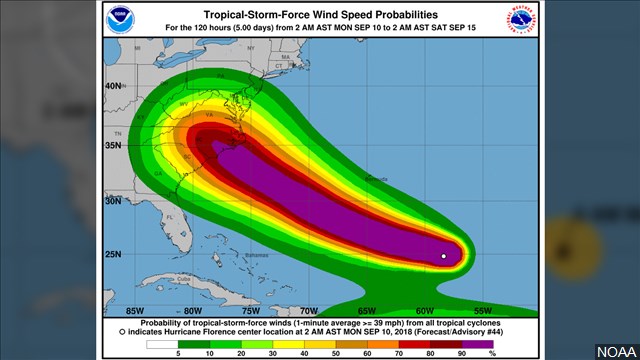Hurricane Florence nears Category 5 strength as it moves toward the Southeast coast
By Emanuella Grinberg, Paul P. Murphy, Kaylee Hartung and Susannah Cullinane, CNN
(CNN) -- The southern East Coast of the United States is bracing for the arrival of Hurricane Florence as the storm -- already packing winds of up to 140 mph -- neared Category 5 strength Tuesday.
More than 1 million people face mandatory evacuation orders in coastal areas of North Carolina, South Carolina and Virginia, where Florence could begin delivering tropical storm force winds late Wednesday.
One year after major storms ravaged the Gulf Coast and Puerto Rico, officials warned those in Florence's path not to underestimate the threat the storm poses.
Residents boarded up their homes, formed long lines at gas stations and emptied the shelves of hardware stores and supermarkets Monday.
As of 11 p.m. ET Monday, Florence had maximum sustained winds of 140 mph, the National Hurricane Center (NHC) said.
"Some strengthening is expected during the next 36 hours, and Florence is expected to be an extremely dangerous major hurricane through Thursday," the NHC said.
The storm is forecast to strengthen to near Category 5 and "there remains high confidence that Florence will be a large and extremely dangerous hurricane, regardless of its exact intensity," the National Hurricane Center said. A Category 5 storm has sustained winds of 157 mph or more.
More counties placed under mandatory evacuations
National Guard soldiers are being mobilized in the affected states. President Donald Trump declared an emergency in North Carolina, allowing it to access federal funds.
Six more North Carolina counties were placed under mandatory evacuation Monday night, hours after the first order in Hatteras Island. Certain areas of Brunswick, Currituck, Dare, Hyde, New Hanover, and Onslow counties are affected, and more orders are expected Tuesday.
In South Carolina, mandatory evacuation orders take effect Tuesday at noon in eight counties along the state's 187-mile coastline. Starting then, all roads on I-26 and Route 501 will be directed away from the coast, South Carolina Gov. Henry McMaster said.
"This is a real hurricane we have coming," McMaster said Monday. "We don't want to risk one South Carolina life."
State government offices, including schools and medical facilities, will be closed in 26 counties, McMaster said. He estimated that about 1 million people will be affected by the order, including residents and visitors.
In Virginia, mandatory evacuations begin 8 a.m. Tuesday for about 245,000 residents in a portion of Hampton Roads and the Eastern Shore area, Gov. Ralph Northam said Monday. "Everyone in Virginia needs to prepare," he said. "This is a serious storm and it's going to affect the entire state of Virginia."
Residents prepare to flee and hunker down
Residents of coastal areas boarded up homes and packed their bags as they braced for Florence's arrival. Lines formed at gas stations as people heeded warnings to gas up in case they're ordered to leave.
Crystal Kirwan didn't think she had much choice as she got her family ready to leave their home Monday. She and her husband will make the 4.5-hour drive with their children to family in Dover, Delaware, as soon as he is cleared from military duty. "Probably not too much better, but most likely safer than here," she said.
Grocery stores began selling out of water, milk and bread, and supply stores were struggling to stock batteries, plywood and generators as early as Sunday.
At a Home Depot in Wilmington, North Carolina, Billy Nivens told CNN they ran out of water, plywood, generators, flashlights, propane, batteries and five-gallon gas cans by Monday afternoon.
Ryan Fonville visited three hardware stores in Wilmington Monday and found that they were running out of supplies.
"I gathered my supplies this weekend, sharing for local community groups so people don't waste gas. The gas pumps are running out as well," Fonville told CNN.
Since noon Sunday, a Lowe's in Lumberton, North Carolina has been sold out of generators, store manager Mackie Singletary said.
In Charleston, South Carolina, the Coburg Dairy Cow landmark was removed for safekeeping from its perch atop a sign on Highway 17 on Monday, according to CNN affiliate WCIV.
Storm growing quickly
Florence became a hurricane Sunday with sustained winds of at least 74 mph. By Monday morning, the hurricane center classified Florence as a "major" Category 3 hurricane, with sustained winds of at least 111 mph. It was picking up speed over the Atlantic's warm waters, causing concerns about landfall and flooding from heavy rains afterward, possibly late Thursday or Friday.
About an hour after the Category 3 upgrade, the storm was reclassified once again, now as Category 4. That means sustained winds of at least 130 mph and expectations of catastrophic damage, the hurricane center says.
States of emergency were declared in the Carolinas, Virginia and Maryland. In Maryland, where some coastal areas are still recovering from weather, Gov. Larry Hogan said flooding could be catastrophic if it hits the state.
"We are hoping for the best and preparing for the worst," Hogan said.
North Carolina Gov. Roy Cooper urged residents to prepare for lengthy power outages after the hurricane arrives and learn evacuation routes they may need to take.
"North Carolina is taking Hurricane Florence seriously, and you should, too," Cooper said. "Action today can avoid losses due to Florence."
Two other storms also are churning in the Atlantic. Hurricanes Helene and Isaac are not expected to hit the US mainland.
The-CNN-Wire
™ & © 2018 Cable News Network, Inc., a Time Warner Company. All rights reserved.


